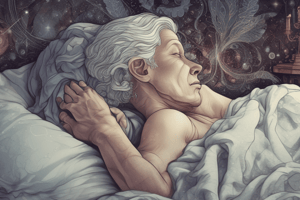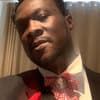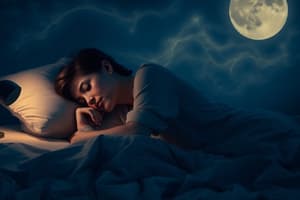Podcast
Questions and Answers
Dyssomnia includes both insomnia and hypersomnia as types of sleep difficulties.
Dyssomnia includes both insomnia and hypersomnia as types of sleep difficulties.
True (A)
Persistent sleep difficulties are not significantly associated with adverse physical health outcomes.
Persistent sleep difficulties are not significantly associated with adverse physical health outcomes.
False (B)
ICD-10 and DSM-5 classify sleep disorders in the same way.
ICD-10 and DSM-5 classify sleep disorders in the same way.
False (B)
Secondary sleep disorders may be symptoms of psychiatric disorders.
Secondary sleep disorders may be symptoms of psychiatric disorders.
Kleine-Levin syndrome is classified as a non-psychogenic sleep disorder in ICD-10.
Kleine-Levin syndrome is classified as a non-psychogenic sleep disorder in ICD-10.
The DSM-5 recognizes only five categories of sleep disorders.
The DSM-5 recognizes only five categories of sleep disorders.
Parasomnias are related to behaviors associated with sleep.
Parasomnias are related to behaviors associated with sleep.
Emotional causes are categorized under 'organic sleep disorders' in ICD-10.
Emotional causes are categorized under 'organic sleep disorders' in ICD-10.
Narcolepsy can be diagnosed primarily through the Epworth Sleepiness Scale.
Narcolepsy can be diagnosed primarily through the Epworth Sleepiness Scale.
The predominant cause of Breathing-Related Sleep Disorder is hereditary.
The predominant cause of Breathing-Related Sleep Disorder is hereditary.
Kleine-Levin Syndrome primarily affects adult women.
Kleine-Levin Syndrome primarily affects adult women.
Circadian Rhythm Sleep Disorder can result from irregular work schedules.
Circadian Rhythm Sleep Disorder can result from irregular work schedules.
Modafinil is an amphetamine used to treat excessive daytime sleepiness in narcolepsy.
Modafinil is an amphetamine used to treat excessive daytime sleepiness in narcolepsy.
Antidepressants such as Venlafaxine can help manage symptoms of narcolepsy.
Antidepressants such as Venlafaxine can help manage symptoms of narcolepsy.
Sodium oxybate primarily enhances daytime alertness in patients with narcolepsy.
Sodium oxybate primarily enhances daytime alertness in patients with narcolepsy.
The prevalence of Breathing-Related Sleep Disorder is about 4% in the female population.
The prevalence of Breathing-Related Sleep Disorder is about 4% in the female population.
Video recording is a common method used for assessing sleep disturbances.
Video recording is a common method used for assessing sleep disturbances.
Cognitive therapy is not considered an effective treatment for insomnia.
Cognitive therapy is not considered an effective treatment for insomnia.
Melatonin is classified as a non-pharmacological treatment for insomnia.
Melatonin is classified as a non-pharmacological treatment for insomnia.
A sleep diary should be maintained for a period of at least one week.
A sleep diary should be maintained for a period of at least one week.
Short-acting benzodiazepines are not commonly used for treating insomnia.
Short-acting benzodiazepines are not commonly used for treating insomnia.
It is advisable to use mobile devices in bed to help fall asleep.
It is advisable to use mobile devices in bed to help fall asleep.
Caffeine-containing drinks should be consumed only in the morning to avoid disturbing sleep.
Caffeine-containing drinks should be consumed only in the morning to avoid disturbing sleep.
Recognizing factors that worsen sleep is an important part of evaluating sleep history.
Recognizing factors that worsen sleep is an important part of evaluating sleep history.
Puberty triggers a change towards morning preference in adolescents.
Puberty triggers a change towards morning preference in adolescents.
Night terrors are more common than nightmares in children.
Night terrors are more common than nightmares in children.
Sleepwalking disorder typically occurs during deep REM sleep.
Sleepwalking disorder typically occurs during deep REM sleep.
Restless legs syndrome can be mistaken for a psychiatric symptom.
Restless legs syndrome can be mistaken for a psychiatric symptom.
Excessive daytime sleepiness affects approximately 1 in 200 people.
Excessive daytime sleepiness affects approximately 1 in 200 people.
Parasomnias only occur in children and cannot affect adults.
Parasomnias only occur in children and cannot affect adults.
Type 1 narcolepsy is characterized by normal levels of orexin-A in the cerebrospinal fluid.
Type 1 narcolepsy is characterized by normal levels of orexin-A in the cerebrospinal fluid.
Narcolepsy may be triggered by infections or other stimuli, indicating it could have an autoimmune aspect.
Narcolepsy may be triggered by infections or other stimuli, indicating it could have an autoimmune aspect.
Episodes of sleep paralysis are often accompanied by extreme calm.
Episodes of sleep paralysis are often accompanied by extreme calm.
Shift-work sleep disorder is listed as one of the causes of excessive daytime sleepiness.
Shift-work sleep disorder is listed as one of the causes of excessive daytime sleepiness.
The peak frequency for nightmares occurs around ages 5 or 6.
The peak frequency for nightmares occurs around ages 5 or 6.
HLA-DQB1*06:02 genotype increases the risk of narcolepsy by a factor of around 100.
HLA-DQB1*06:02 genotype increases the risk of narcolepsy by a factor of around 100.
Clonazepam and donepezil are considered effective treatments for REM sleep behavior disorder.
Clonazepam and donepezil are considered effective treatments for REM sleep behavior disorder.
Night terror disorder can persist into adulthood without any familial ties.
Night terror disorder can persist into adulthood without any familial ties.
Type 2 narcolepsy is always associated with cataplexy.
Type 2 narcolepsy is always associated with cataplexy.
Approximately 15-30% of the general population possess the HLA-DQB1*06:02 genotype.
Approximately 15-30% of the general population possess the HLA-DQB1*06:02 genotype.
15% of children aged 5 to 12 will walk in their sleep at least once.
15% of children aged 5 to 12 will walk in their sleep at least once.
Obstructive sleep apnoea is not mentioned as a cause of excessive daytime sleepiness.
Obstructive sleep apnoea is not mentioned as a cause of excessive daytime sleepiness.
The DSM-5 classifies insomnia disorder under breathing-related sleep disorders.
The DSM-5 classifies insomnia disorder under breathing-related sleep disorders.
Excessive sleepiness affects approximately 5% of adults.
Excessive sleepiness affects approximately 5% of adults.
In the ICD-10, narcolepsy is classified as a non-organic sleep disorder.
In the ICD-10, narcolepsy is classified as a non-organic sleep disorder.
Transient insomnia can occur due to stress or jet lag.
Transient insomnia can occur due to stress or jet lag.
The International Classification of Sleep Disorders (ICSD 3) identifies over 100 types of sleep disorders.
The International Classification of Sleep Disorders (ICSD 3) identifies over 100 types of sleep disorders.
ICD-10 requires insomnia to be present for at least three nights a week for one month to be diagnosed.
ICD-10 requires insomnia to be present for at least three nights a week for one month to be diagnosed.
Restless legs syndrome is included in both DSM-5 and ICD-10 classifications of sleep disorders.
Restless legs syndrome is included in both DSM-5 and ICD-10 classifications of sleep disorders.
Sleepwalking is classified as a breathing-related sleep disorder in ICD-10.
Sleepwalking is classified as a breathing-related sleep disorder in ICD-10.
The identification of primary nocturnal enuresis falls under the sleep disorders of organic origin category in ICD-10.
The identification of primary nocturnal enuresis falls under the sleep disorders of organic origin category in ICD-10.
Only 4% of adults meet the criteria for insomnia in the ICD-10 classification.
Only 4% of adults meet the criteria for insomnia in the ICD-10 classification.
Flashcards are hidden until you start studying
Study Notes
Overview of Sleep Disorders
- Growing awareness of sleep problems' impact on mental and physical health has led to increased specialization in sleep medicine.
- Sleep disorders encompass both dyssomnias (insomnia, hypersomnia) and parasomnias (behaviors associated with sleep).
- Sleep issues can indicate primary sleep disorders, be a symptom of psychiatric conditions, or contribute to psychiatric disorders.
Persistent Sleep Difficulties
- Persistent sleep issues are linked to various negative physical health outcomes.
Classification of Sleep Disorders
- DSM-5 identifies 10 sleep-wake disorders including insomnia disorder, hypersomnolence disorder, and narcolepsy.
- ICD-10 categorizes sleep disorders based on aetiology, including non-organic and organic sleep disorders.
Assessment of Sleep Disturbance
- Key screening questions evaluate sleep quality, daytime sleepiness, and nighttime disturbances.
- A comprehensive sleep history and sleep diary help document sleep patterns and related factors.
- Investigations may include actigraphy, polysomnography, and cerebrospinal fluid analysis.
Treatments for Insomnia
- Cognitive and Behavioral Interventions focus on sleep hygiene, sleep restriction, and relaxation techniques.
- Pharmacological Treatments range from short-acting benzodiazepines to melatonin agonists and low-dose sedative antidepressants.
Principles of Sleep Education (Sleep Hygiene)
- Optimal sleep environment: familiar, dark, and quiet.
- Recommended practices include regular bedtime, limited screentime before sleep, and consistent routines.
- Activities to avoid: late exercise, caffeine, excessive alcohol, and large meals before bed.
Insomnia
- Defined as unsatisfactory sleep quality or quantity with difficulty falling asleep, staying asleep, or waking too early.
- Often secondary to other conditions like depression, anxiety, or physical ailments.
- Diagnosis requires persistent insomnia occurring at least three nights per week for a month (ICD-10) or three months (DSM-5).
Narcolepsy
- A neurological disorder characterized by excessive daytime sleepiness, cataplexy, and hypnagogic hallucinations.
- Type 1 narcolepsy involves reduced orexin-A levels and is linked to specific genetic markers (HLA-DQB1*06:02).
- Treatment includes sleep management, stimulant medications, and occasionally antidepressants.
Breathing-Related Sleep Disorder
- Defined by daytime drowsiness with recurrent apneas, often linked to upper airway obstruction.
- About 4% of males are affected, with management focused on addressing the underlying causes and promoting weight loss.
Kleine-Levin Syndrome
- Rare disorder marked by episodes of excessive sleep, hyperphagia, and hypersexuality.
- Affects primarily adolescent boys, with unknown causes and variable treatment approaches, including stimulants and mood stabilizers.
Circadian Rhythm Sleep Disorder
- Encompasses conditions like jet lag and shift-work disorder, leading to fatigue and sleep disturbances due to irregular sleep patterns.
Hypersomnia and Excessive Daytime Sleepiness
- Commonly underdiagnosed, with prevalence estimates of 3-5%.
- Can result from insufficient sleep, medical disorders, or sedative medication use.
Parasomnias
- Abnormal behaviors accompanying sleep, prevalent in children and increasing with age-related disorders.
- Nightmares: Typically peak during childhood; related to anxiety and stressful experiences.
- Night Terrors: More common in childhood; involve episodes of terror within hours of sleep onset.
- Sleepwalking: Typically occurs in children; characterized by repetitive movements or walking while seemingly asleep.
- REM Sleep Behavior Disorder: Agitation during REM sleep; may precede neurodegenerative diseases.
- Restless Legs Syndrome: Painful condition causing disruptive sleep; prevalent among women and the elderly.
- Sleep Paralysis: Characterized by temporary inability to move during sleep transition, often accompanying fear.
Accidents and Behavioral Effects
- Sleep disorders can increase the risk of accidents and significantly impact social and emotional well-being, especially in adolescents.
Studying That Suits You
Use AI to generate personalized quizzes and flashcards to suit your learning preferences.





